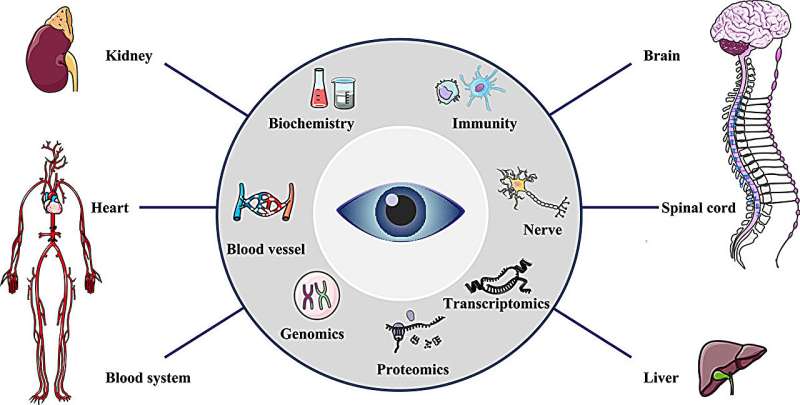This article has been reviewed according to Science X's editorial process and policies. Editors have highlighted the following attributes while ensuring the content's credibility:
fact-checked
proofread
Progress in the diagnosis of systemic diseases based on ophthalmic imaging artificial intelligence technology

The eye is a unique window to overall health. Its associated medical imaging has great characteristics, such as being non-invasive, convenient, and rich in information, which offers significant potential for developing new technologies for diagnosing systemic diseases.
Research reveals that ocular features can reflect not only the health of the eye but also abnormalities in multiple organs and systems, including the brain, heart, liver, and kidneys. With the rapid advancement of artificial intelligence (AI) and ophthalmic imaging technology, medical experts are exploring new methods to predict and diagnose systemic diseases through ocular images.
Recently, the research team led by Gao Yuanxu, a researcher from Macau University of Science and Technology, published a review article titled "Advancing systemic disease diagnosis through ophthalmic image‐based artificial intelligence" in MedComm – Future Medicine. Miao Hanpei from Southern Medical University served as the first author.
The article comprehensively summarizes the physiological basis of eye examinations in diagnosing systemic diseases, common ophthalmic imaging modalities, and AI technologies related to ophthalmic image analysis. It also explores the research and application of these AI technologies in various systemic diseases. Furthermore, the paper delves into the current challenges faced in this field and the prospects for future development.
The anatomical and physiological characteristics of the eye make it a crucial structure for understanding overall health. This is largely due to the eye sharing complex vascular and neural networks and physiological processes with various other organs. The vascular system, nervous system, biochemical, immunological, and "omics" information of the eye provide valuable clues for assessing overall health.
With the help of ophthalmic imaging, such as color fundus photography(CFP), optical coherence tomography(OCT), optical coherence tomography angiography(OCTA), and slit lamp examination, researchers can collect structural information of the eye from multiple dimensions, thereby analyzing and understanding systemic diseases.
The review outlines two primary modes of ocular image analysis: one is the end-to-end AI approach, which learns from massive image data to develop auxiliary screening and diagnostic models for systemic diseases; the other is performing feature engineering based on prior medical knowledge and modeling with traditional machine learning methods to develop more interpretable AI models.
This article systematically summarizes the extensive applications of ophthalmic AI in systemic diseases, including nervous system diseases, cardiovascular diseases, kidney diseases, hepatobiliary diseases, and hematologic system diseases, providing a comprehensive overview of the application of ophthalmic AI models.
The application of ophthalmic AI for diagnosing systemic diseases still faces challenges related to data heterogeneity, model interpretability, as well as the accuracy and specificity of multi-disease and multi-label classification tasks.
This article emphasizes that future research should consider integrating multimodal and multi-omics information for comprehensive analyses. It also highlights the significant potential for the application of emerging AI technologies, such as blockchain and large language models (like ChatGPT), to enhance ophthalmic AI.
In summary, AI systems based on ophthalmic imaging have shown unprecedented potential in diagnosing systemic diseases, and future research needs to delve into how to extract undiscovered clinical information from ophthalmic AI models and explore effective ways to translate these technologies into clinical practice.
More information: Hanpei Miao et al, Advancing systemic disease diagnosis through ophthalmic image‐based artificial intelligence, MedComm – Future Medicine (2024). DOI: 10.1002/mef2.75


















